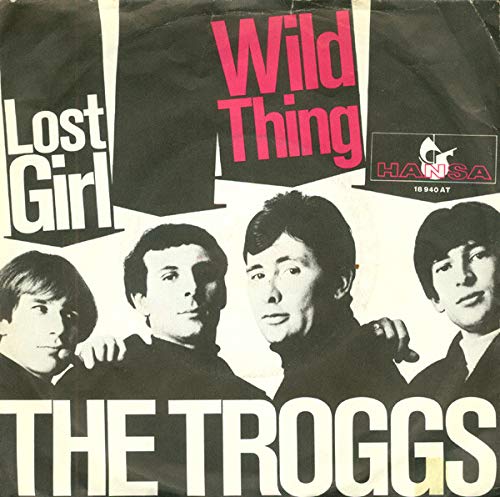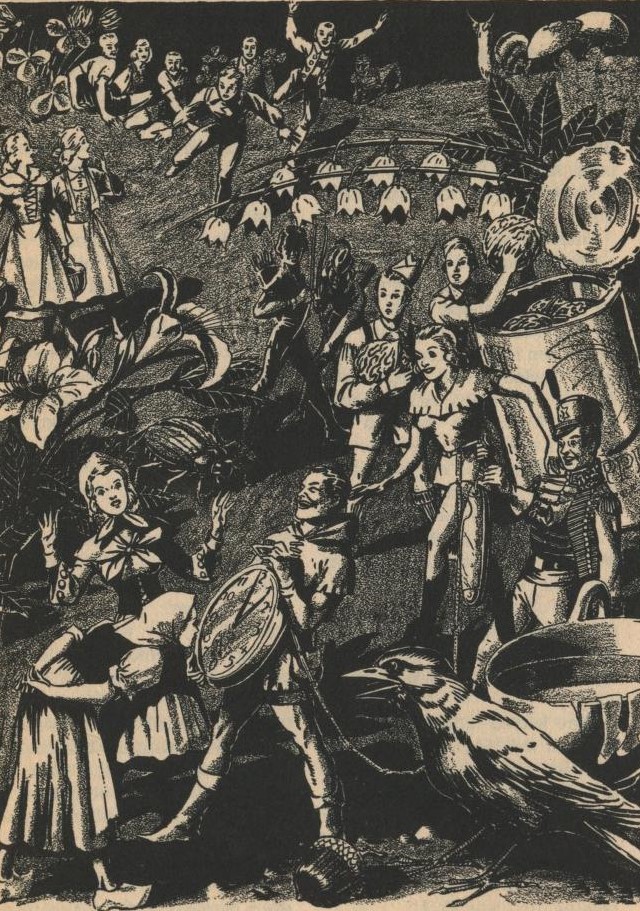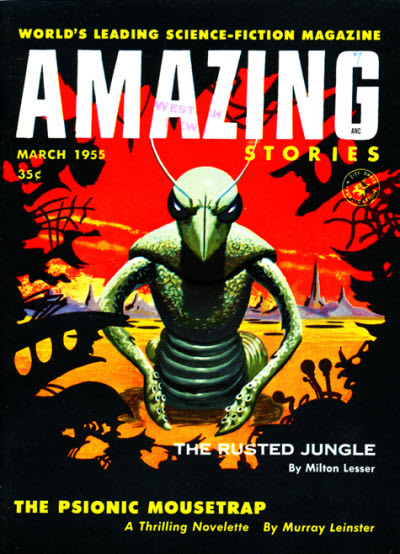
by Victoria Silverwolf
Render Unto Caesar
There's a new way to lose your money when visiting Las Vegas. A hotel, showroom, and casino called Caesars Palace (no apostrophe) opened a few days ago. As the name implies, it has an ancient Rome theme rather than the Western theme found in most gambling dens in Sin City.

A showgirl advertises the grand opening. I don't think that's an authentic costume of the time.
The inauguration ceremony is said to have cost one million dollars, including money spent on huge amounts of caviar, filet mignon, crabmeat, and champagne.

A page from a brochure advertising the place. Or possibly an illustration for a time travel story.
The Deuce Gets Loose
Speaking of losing money, today the United States Department of the Treasury announced that it would no longer print two-dollar bills. (The U.S. Mint hadn't actually printed any since June 30, but now they're going to stop completely.)

Thomas Jefferson looks glum about the situation. At least he'll still be on the nickel.
Two-dollar bills only make up a tiny percentage of the paper money in circulation. Some folks think they're unlucky. They're welcome to give any they don't want to me.
Wild Success
One thing you can do with a two-dollar bill is buy a couple of 45 rpm single records, and maybe even have a little change left over. A lot of people are shelling out a buck or so for the current Number One smash hit Wild Thing by the British band the Troggs. This raw, energetic tune was originally recorded last year by an American group called, appropriately enough, the Wild Ones, but failed to reach the charts.

It's the only rock 'n roll hit I can recall that features an extended ocarina solo.
You Pays Your Money And You Takes Your Choice
If you've only got fifty cents to your name, you can still purchase a copy of the current issue of Fantastic. That's less than one-third of a cent per page, so it sounds like a pretty good deal.
Of course, as my esteemed colleague John Boston recently pointed out, both Amazing and Fantastic are publishing lots of reprints without paying the authors. Whether you want to support these publications or boycott them is your choice. As for me, duty calls.

Cover art by Frank R. Paul.
Of course, the image on the front is also a reprint, and I doubt it was paid for either. In any case, it comes from the back cover of the April 1942 issue of Amazing Stories.

Here's the original painting, titled City of the Future. Looks a lot better this way, doesn't it?
For a Breath I Tarry, by Roger Zelazny
As the cover announces, here's the author's newest story.
Wait a minute! Haven't I read this before? Let me see, where could it have been?
Oh, yeah, it appeared in the March issue of New Worlds, and was reviewed by my esteemed colleague Mark Yon just a few months ago. I hope the author got paid twice.

Anonymous cover art.
I cannot hope to match the quality of this outstanding article. I will simply offer my own views, for whatever they might be worth.

Illustrations by Gray Morrow.
Long after humanity has disappeared, Earth is controlled by machines. Orbiting the planet is the supreme ruler, Solcom. Dwelling deep underground is a rival machine, named Divcom. (An allegory with God and the Devil seems intended, and some of the story reminds me of the Book of Job. However, the plot is completely original, and not merely a retelling of the Bible story.)
Solcom creates a machine to rule the northern hemisphere, calling it Frost. The ruler of the southern hemisphere is Beta. Frost makes a hobby of studying what little remains of humanity's relics. A machine named Mordel, in the service of Divcom, comes to Frost with a supply of ancient books. These excite Frost's curiosity, and it sets out on a quest to understand human emotions; in fact, to become a human being. Mordel offers Frost a deal. It will give Frost all the aid it requires to achieve this goal, but if Frost comes to realize that the task is impossible, it will have to serve Divcom forever.
(An allusion to the legend of Faust also seems intended. Note the similarity in names.)
Frost travels to the southern hemisphere, in order to witness one of the last places where people dwelled. This act is in defiance of Solcom's will, leading to a conflict between creator and created. (We are told that a temporary malfunction in Solcom's operation, at the time it made Frost, caused Frost to be unique among machines. Perhaps this is a form of original sin.)

What Frost wants to be.
I have barely touched the surface of a remarkable story. I haven't mentioned, for example, the giant ore-digging machine that carries the remains of the human being it accidentally killed within itself, causing all the machines it encounters to listen to its story. The fact that it bears parts of a dead human is enough to make other machines obey it, a subtle and important point. I also haven't talked about the role Beta plays in the plot. Go see for yourself.
Five stars.
"You Can't See Me!", by William F. Temple
If we allow the Zelazny tale to be considered new, our first reprint comes from the June 1951 issue of Fantastic Adventures.

Cover art by Walter H. Hinton.
A fellow discovers that the people around him are happily conversing with folks he can't see. At first, a few others witness the same peculiarity, assuming the chatterers are crazy. Soon everybody succumbs to the delusion, and only the protagonist doesn't have an imaginary companion.

Illustration by Gerald Hohns. I assume all the reprinted drawings failed to earn the artists any new money, just like the writers.
Of course, there's an explanation for this strange happening. It's a pretty weak one, unfortunately, and the story just kind of fizzles out toward the end. Although it's not really a comedy, the fact that the main character has the unlikely name Zechariah Zebedee Zyzincwicz, and that this unusual moniker is relevant to the plot, tells you that you shouldn't take it too seriously.
Two stars.
Carousel, by August Derleth
This chiller comes from the April 1945 issue of Fantastic Adventures.

Cover art by R. E. Epperley.
A little girl lives with her father and a wicked stepmother, straight out of a fairy tale. The evil woman is insanely jealous of the man's affection for his daughter, and would even be happy to see her dead.

Illustrations by Robert Fuqua.
A few years before the story begins, a mob lynched a carnival worker, leaving behind a wrecked merry-go-round. The child often goes to play in the ruins, claiming to be friends with a black man. The wicked stepmother takes advantage of the situation to make sure the girl is punished for her actions, whipping her severely. She follows her to the merry-go-round, hoping that the dangerous machinery will cause the child to suffer a fatal accident. (The implication that the woman intends to cause the accident is pretty clear.) Things don't work out the way she expects.

The haunted carousel.
As you can probably tell from this synopsis, there are no surprises at all in the plot. It's a pretty ordinary horror story, of the supernatural punishment variety. Although the murder of the carnival worker is obviously due to racial hatred, this isn't really relevant, which lessens the story's impact.
Three stars.
The Little People, by Eando Binder
This fantasy novella first appeared in the March 1940 issue of Fantastic Adventures.

Cover art by Robert Fuqua.
A scientist, his adult daughter, and her boyfriend are in a cabin somewhere in a remote area. The gruesome discovery of a cat with its throat cut is the first hint that something weird is going on. The next odd happening is the disappearance of a gold watch.
We find out right away that a community of fairies, or whatever you want to call them, is located nearby. One of them went into the cabin to steal the watch as a sign of bravery, in order to win the hand of the woman he loves, and had to kill the cat to escape.

Illustrations uncredited. They might be by Robert Fuqua again.
A rival for the fairy woman's affection tries to outdo the other by stealing a pair of binoculars. He gets caught by the scientist, who wants to exploit the little people as a scientific curiosity. The two young people are more sympathetic to their plight. The rival acts as a traitor to his kind, helping the scientist capture others.

Happier times, before the big people trap them.
The fairy man who stole the watch undertakes the dangerous task of rescuing his people from their captor, as well as defeating the treacherous rival.
I may as well mention here that Eando Binder is a pseudonym, used by brothers Earl (deceased) and Otto Binder. They're best known for a series of stories about the robot Adam Link. My sources tell me that this story is the work of Otto alone. In any case, it's not a bad fairy tale, if not outstanding in any way. Animal lovers should be warned that the cat is not the only creature to fall victim to the diminutive hero.
Three stars.
The Psionic Mousetrap, by Murray Leinster
The March 1955 issue of Amazing Stories is the source for this Cold War thriller.

Cover art by Edward Valigursky.
Our hero parachutes into the Soviet Union on a suicide mission. His grim task is to kill a kidnapped scientist before he can reveal the secrets of powerful psionic technology to the Reds.

Illustration by Paul Orban.
Things go badly right from the start. The hero winds up in the hands of the enemy. They force him to complete the work of the captured scientist, which turns out to be their undoing.
I didn't get much out of this spy yarn. The plot depends on the fact that the Commies are too materialistic to believe in psionics, which was a little hard to swallow. The story's conclusion strains credulity as well. You'd expect something like this in a mediocre issue of Astounding, given the fact that psionics is pretty much just another word for magic.
Two stars.
No More Tomorrows, by David H. Keller, M.D.
Here's a Kelleryarn (as they used to call the works of this author) from the December 1932 issue of Amazing Stories.

Cover art by Leo Morey.
The narrator develops a substance that destroys the part of the brain that allows one to imagine the future. He plans to sell the secret of this stuff to a trio of Soviet agents for a ton of money.

Illustration by Leo Morey also.
He rather stupidly whips up a vial of the substance, as well as a vial of plain water, in order to brag about his plot to the woman he wants to marry. (He figures that being a multimillionaire will win her hand.) Predictably, she winds up switching the two vials, so the narrator is hoist by his own petard.
This story has an intriguing premise, but it isn't developed very well. As I've indicated, the switching of the two vials requires that the narrator act like a complete fool. (There doesn't seem to be any reason at all to have a vial of water around.) The three Soviet agents are bizarrely deformed, as the illustration indicates. I guess the author really hates Communism, but this makes the whole thing seem ridiculous.
Two stars.
Rocket to Gehenna, by Doris Piserchia
At last! A story that hasn't appeared anywhere else. It's the author's first publication, too. It's a comic tale in the form of a series of letters. (A work of epistolary fiction, for those of you with highfalutin vocabularies.)
It seems that Earth sends the bodies of the deceased to the supposedly uninhabited planet Gehenna. It turns out that the place is occupied by a caterpillar-like alien and a very naïve human boy. Since they have the power to transport anything from one place to another, they start sending bodies back to Earth. The boy also captures a woman, because he thinks he needs a wife, although he doesn't even know the basic anatomical facts of life.
This is all very silly stuff. It's obviously trying to be a wacky farce, but I didn't find it very amusing. Let's hope the author does better work in the future.
One star.
Did You Get Your Money's Worth?
The Zelazny story, all by itself, is worth the four bits you'll pay for the magazine. The rest of it goes downhill at a rapid pace. If you have half a buck to spare, you might want to give it a try.

That isn't exactly what I had in mind.
A copy of Rosel George Brown's new hit novel, Sibyl Sue Blue, is worth every penny! Buy one today!

![[August 10, 1966] Dollars and Cents (September 1966 <i>Fantastic</i>)](https://galacticjourney.org/wp-content/uploads/2021/08/FANTSEP1966-3.jpg)

